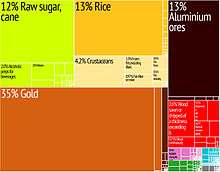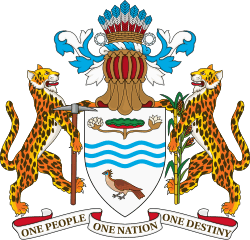Economy of Guyana
With a per capita gross domestic product of $8,300 in 2016 and an average GDP growth of 4.2% over the last decade, Guyana is one of the fastest developing countries in the Western Hemisphere. It is expected to achieve GDP growth of 53% in 2020.[4][13]
 | |
| Currency | Guyanese dollar (GYD) |
|---|---|
| Calendar year | |
Trade organisations | CARICOM, WTO, Prosur, Unasur, Mercosur (associate) |
Country group |
|
| Statistics | |
| GDP | |
| GDP rank | |
GDP growth |
|
GDP per capita | |
GDP per capita rank | |
GDP by sector |
|
| 1.8% (2020 est.)[4] | |
Population below poverty line | 35% (2006 est.)[6] |
| 44.6 medium (2007)[6] | |
Labour force | |
Labour force by occupation | N/A |
| Unemployment | |
Main industries | bauxite, sugar, rice milling, timber, textiles, gold mining |
| External | |
| Exports | |
Export goods | sugar, gold, bauxite, alumina, rice, shrimp, molasses, rum, timber |
Main export partners |
|
| Imports | |
Import goods | manufactures, machinery, petroleum, food |
Main import partners |
|
FDI stock | N/A |
Gross external debt | |
| Public finances | |
| −4.5% (of GDP) (2017 est.)[6] | |
| Revenues | 1.002 billion (2017 est.)[6] |
| Expenses | 1.164 billion (2017 est.)[6] |
| Economic aid | $84 million |
Foreign reserves | |

Overview
The economy made dramatic progress after President Hoyte's 1989 economic recovery program (ERP). As a result of the ERP, Guyana's GDP increased six percent in 1991 following 15 years of decline. Growth was consistently above six percent until 1995, when it dipped to 5.1 percent. The government reported that the economy grew at a rate of 7.9 percent in 1996, 6.2 percent in 1997, and fell 1.3 percent in 1998. The 1999 growth rate was three percent. The unofficial growth rate in 2005 was 0.5 percent. In 2006, it was 3.2%.
Developed in junction with the World Bank and the International Monetary Fund (IMF), the ERP significantly reduced the government's role in the economy, encouraged foreign investment, enabled the government to clear all its arrears on loan repayments to foreign governments and the multilateral banks, and brought about the sale of 15 of the 41 government-owned (parastatal) businesses. The cellphone company and assets in the timber, rice, and fishing industries also were privatized. International corporations were hired to manage the huge state sugar company, GuySuCo, and the largest state bauxite mine. An American company was allowed to open a bauxite mine, and two Canadian companies were permitted to develop the largest open-pit gold mine in South America. However, efforts to privatize the two state-owned bauxite mining companies, Berbice Mining Company and Linden Mining Company have so far been unsuccessful.
Most price controls were removed, the laws affecting mining and oil exploration were improved, and an investment policy receptive to foreign investment was announced. Tax reforms designed to promote exports and agricultural production in the private sector were enacted.
Agriculture and mining are Guyana's most important economic activities, with sugar, bauxite, rice, and gold accounting for 70–75 percent of export earnings. However, the rice sector experienced a decline in 2000, with export earnings down 27 percent through the third quarter 2000. Ocean shrimp exports, which were heavily impacted by a one-month import ban to the United States in 1999, accounted for only 3.5 percent of total export earnings that year. Shrimp exports rebounded in 2000, representing 11 percent of export earnings through the third quarter 2000. Other exports include timber, diamonds, garments, rum, and pharmaceuticals. The value of these other exports is increasing.
Since 1986, Guyana has received its entire wheat supply from the United States on concessional terms under a PL 480 Food for Peace programme. It is now supplied on a grant basis. The Guyanese currency generated by the sale of the wheat is used for purposes agreed upon by the U.S. and Guyana Governments. As with many developing countries, Guyana is heavily indebted. Reduction of the debt burden has been one of the present administration's top priorities. In 1999, through the Paris Club "Lyons terms" and the Heavily Indebted Poor Countries (HIPC) initiative Guyana managed to negotiate $256 million in debt forgiveness.
In qualifying for HIPC assistance, for the first time, Guyana became eligible for a reduction of its multilateral debt. About half of Guyana's debt is owed to the multilateral development banks and 20% to its neighbour Trinidad and Tobago, which until 1986 was its principal supplier of petroleum products. Almost all debt to the U.S. government has been forgiven. In late 1999, net international reserves were at $123.2 million, down from $254 million in 1994. However, net international reserves had rebounded to $174.1 million by January 2001.
Guyana's extremely high debt burden to foreign creditors has meant limited availability of foreign exchange and reduced capacity to import necessary raw materials, spare parts, and equipment, thereby further reducing production. The increase in global fuel costs also contributed to the country's decline in production and growing trade deficit. The decline of production has increased unemployment. Although no reliable statistics exist, combined unemployment and underemployment are estimated at about 30%.
Emigration, principally to the U.S. and Canada, remains substantial. Net emigration in 1998 was estimated to be about 1.4 percent of the population, and in 1999, this figure totaled 1.2 percent. After years of a state-dominated economy, the mechanisms for private investment, domestic or foreign, are still evolving. The shift from a state-controlled economy to a primarily mixed economic system began under Desmond Hoyte and continued under PPP/CIVIC governments. The current PPP/C administration recognizes the need for foreign investment to create jobs, enhance technical capabilities, and generate goods for export.
The foreign exchange market was fully liberalized in 1991, and currency is now freely traded without restriction. The rate is subject to change on a daily basis, but the Guyana dollar has depreciated 17.6% from 1998 to 2000 and may depreciate further pending the stability of the post-election period.
Guyana is a member of the WTO.
Data
The following table shows the main economic indicators in 1980–2017.[14]
| Year | 1980 | 1985 | 1990 | 1995 | 2000 | 2005 | 2006 | 2007 | 2008 | 2009 | 2010 | 2011 | 2012 | 2013 | 2014 | 2015 | 2016 | 2017 |
|---|---|---|---|---|---|---|---|---|---|---|---|---|---|---|---|---|---|---|
| GDP in $ (PPP) |
1.28 Bln. | 1.37 Bln. | 1.38 Bln. | 2.19 Bln. | 2.73 Bln. | 3.14 Bln. | 3.40 Bln. | 3.73 Bln. | 3.88 Bln. | 4.04 Bln. | 4.37 Bln. | 4.59 Bln. | 4.90 Bln. | 5.24 Bln. | 5.54 Bln. | 5.77 Bln. | 6.05 Bln. | 6.29 Bln. |
| GDP per capita in $ (PPP) |
1.690 | 1,862 | 1,915 | 3,014 | 3,675 | 4,223 | 4,567 | 5,003 | 5,189 | 5,380 | 5,669 | 6,076 | 6,469 | 6,890 | 7,254 | 7,533 | 7,874 | 8,161 |
| GDP growth (real) |
−2.0 % | 0.4 % | −3.0 % | 5.0 % | −1.3 % | −1.9 % | 5.2 % | 7.0 % | 1.9 % | 3.3 % | 4.4 % | 5.4 % | 4.8 % | 5.2 % | 3.8 % | 3.1 % | 3.3 % | 2.1 % |
| Inflation (in Percent) |
14.1 % | 15.0 % | 64.3 % | 12.2 % | 6.1 % | 6.9 % | 6.8 % | 12.2 % | 8.1 % | 3.0 % | 4.3 % | 4.4 % | 2.4 % | 1.9 % | 0.7 % | −0.9 % | 0.8 % | 2.1 % |
| Government debt (Percentage of GDP) |
... | ... | ... | ... | 131 % | 119 % | 97 % | 61 % | 63 % | 67 % | 68 % | 67 % | 64 % | 58 % | 52 % | 50 % | 51 % | 51 % |
See also
|
|
References
- "World Economic Outlook Database, April 2019". IMF.org. International Monetary Fund. Retrieved 29 September 2019.
- "World Bank Country and Lending Groups". datahelpdesk.worldbank.org. World Bank. Retrieved 29 September 2019.
- "World Economic Outlook Database, October 2019". IMF.org. International Monetary Fund. Retrieved 22 October 2019.
- "World Economic Outlook Database, April 2020". IMF.org. International Monetary Fund. Retrieved 21 April 2020.
- "Global Economic Prospects, June 2020". openknowledge.worldbank.org. World Bank. p. 86. Retrieved 16 June 2020.
- "The World Factbook". CIA.gov. Central Intelligence Agency. Retrieved 10 February 2019.
- "Human Development Index (HDI)". hdr.undp.org. HDRO (Human Development Report Office) United Nations Development Programme. Retrieved 11 December 2019.
- "Inequality-adjusted Human Development Index (IHDI)". hdr.undp.org. HDRO (Human Development Report Office) United Nations Development Programme. Retrieved 11 December 2019.
- "Labor force, total - Guyana". data.worldbank.org. World Bank. Retrieved 14 January 2020.
- "Employment to population ratio, 15+, total (%) (national estimate) - Guyana". data.worldbank.org. World Bank. Retrieved 14 January 2020.
- The World Bank (April 2019). "Unemployment, total (% of total labor force) (modeled ILO estimate)". Retrieved 11 September 2019.
- "Ease of Doing Business in Guyana". Doingbusiness.org. Retrieved 2017-01-23.
- "World Economic Outlook Database, October 2019". IMF.org. International Monetary Fund. Retrieved 12 January 2020.
- "Report for Selected Countries and Subjects". Retrieved 2018-09-19.


.svg.png)